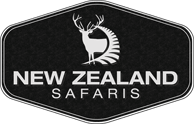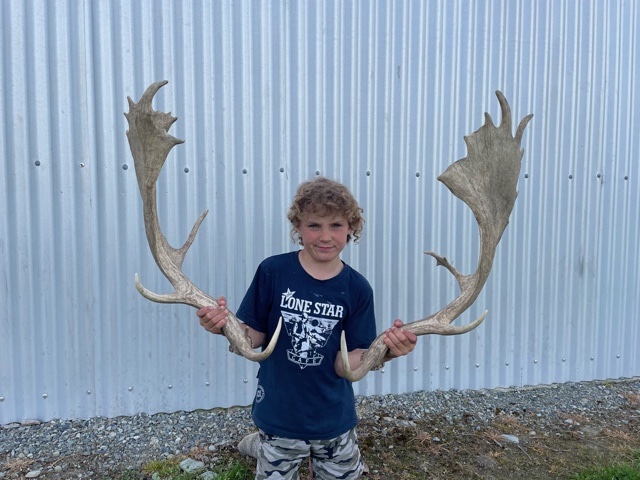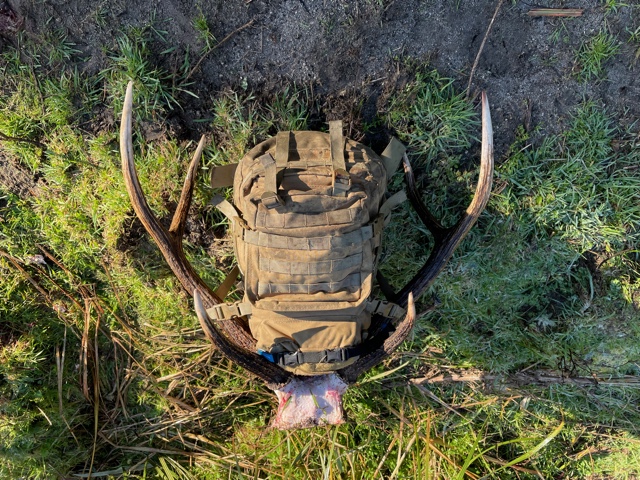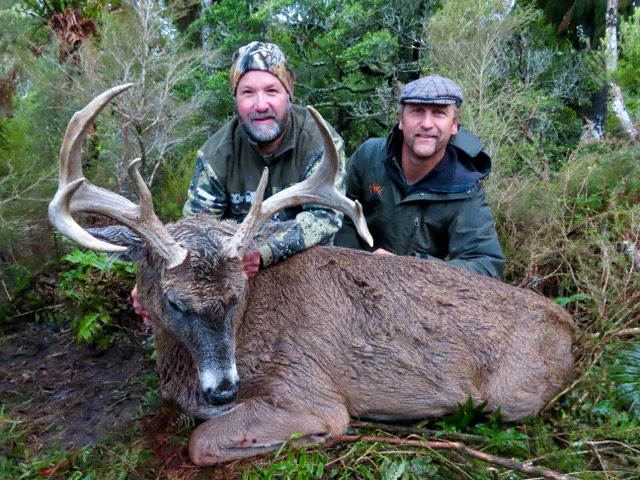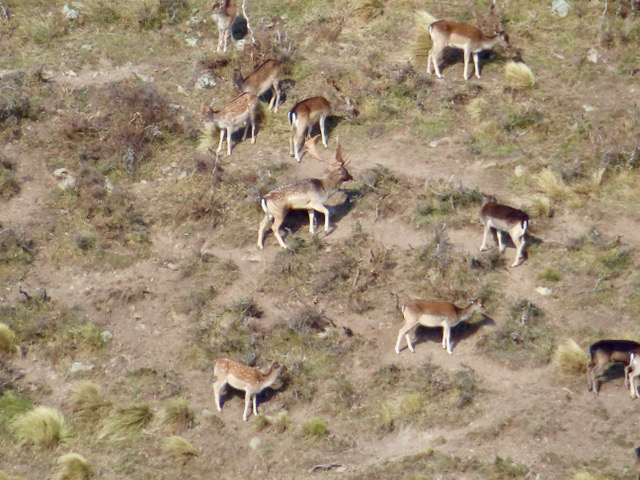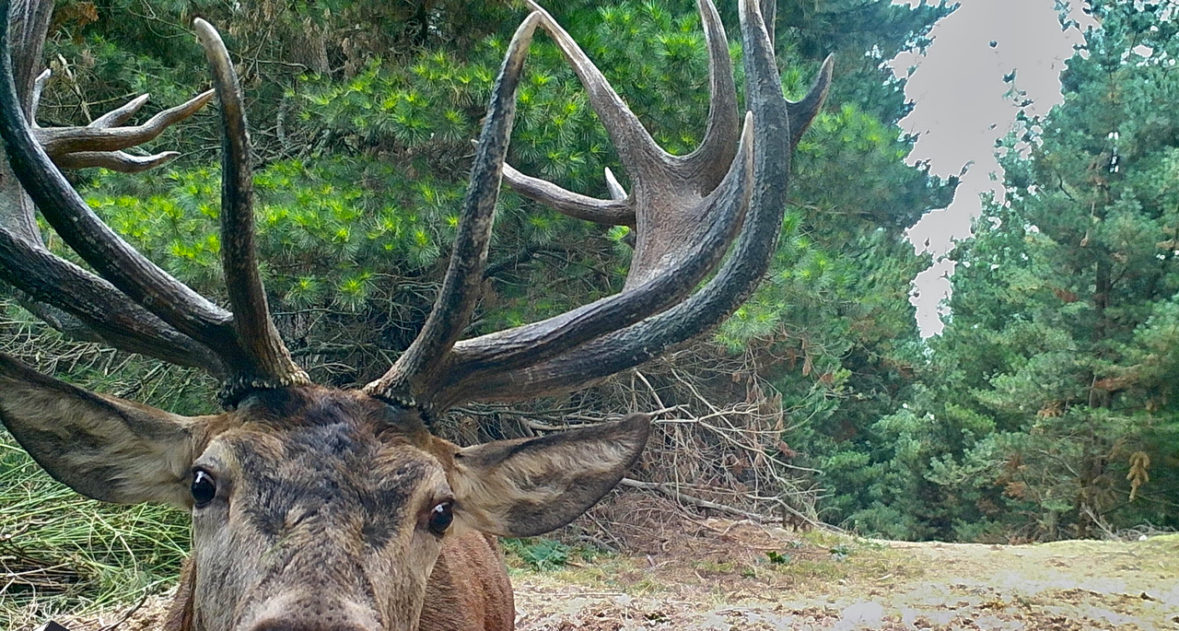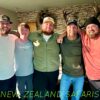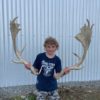Well we’re getting to the tail end of the year again. Summer is all but here in New Zealand with all the deer growing out their velvet antlers. We have picked up a few so far including this giant set of Elk antlers at over 53 inches long on the main beam and 12 inch mass I would think this set would go well into the 400 inches+ class. Also this huge set of Fallow buck antlers from our local `big Bucky Buck` which will be interesting to see if he cracks the legendary 300 inches mark.
Sambar deer hunting in New Zealand is one of the most challenging wild and free range hunts we have in the country. Larger in body size than Red Stags Sambar stags are more spend most of their lives in heavy cover seldom venturing into the open. Sambar Stag are typical in antler formation having 3 points on either side but with very heavy mass, rough pearling on the antlers and dark. The females will have one fawn a year and tan brown in colour when alerted Will make a hong alarm. Sambar deer in New Zealand will rut from late May-mid August which is one of the longest mating seasons for animals in New Zealand which is very typical of tropical deer that were introduced into New Zealand. Sambar deer hunting in New Zealand is predominantly on private land or forestry, most Stags are hunted at night with a light or with dogs, Jim Gibson owner of New Zealand Safaris is one of the very few New Zealand Hunting Outfitters that offer wild free ranging Sambar deer hunts on private land in the traditional spot and stalk hunting method.
Whitetail deer are only in the South Island of New Zealand, which has the only herds of white-tail deer in the southern hemisphere. The history of New Zealand Whitetail started in 1901 when a group of deer were released in the Takaka Valley Nelson. For reasons not documented or known this liberation failed, like the Mule deer and Black tail deer that were also released around the same time. But all was not lost when in 1904 the World’s Fair was held to commemorate the 100th anniversary of the Louisiana Purchase, this amazing show in St. Louis, Missouri, was a sight to behold. Covering more than 1,200 acres and playing host to nearly 20 million visitors over a seven-month span, it was up to that point the most spectacular such event in history, and it remains the largest world’s fair ever held today. Nearly all of the then-45 states had lavish displays of their resources, as did around 60 other countries from all over the globe.
What makes the 1904 World’s Fair relevant to New Zealand is that of the many exhibits on display there, one included a herd of whitetails. Reportedly they had been trapped in deep snow in New Hampshire and then taken to St. Louis, though precisely when, how and by whom they were captured and transported no one today seems certain. What we do know is that at the time there were probably only around a half-million whitetails on earth, a crowd likely had never seen one. Apparently President Theodore Roosevelt decided to give these whitetails to New Zealand. And so, at some time in late 1904 or early 1905, a ship carrying them headed down the Mississippi River from St. Louis, bound for New Zealand. Remarkably, of the 22 deer that went onto the ship, 18 of them — four bucks and 14 does — made it across the Pacific alive which was a 12,000 mile journey by boat. On Saturday March 26 nine of the Virginian deer were sent to Pegasus Sound, Stewart Island, and the remaining nine were forwarded to Rees Valley, Lake Wakatipu in the lower part of the South Island. Whitetail deer in New Zealand have 2 main well established herds, and are doing well although the mainly land herds are bigger in body and antler than those on Stewart Island both herds are smaller in trophy potential than those in North America due to the lack of genetic diversity. Today thanks to a private land owners passion for these deer New Zealand Safaris has exclusive access to hunting Whitetail deer on this privately owned hunting property. This herd of New Zealand Whitetail come from both the Stewart Island herd, and Wakatipu herd which has given them a very unique trophy potential. With huge bodies and heavy mass of main beams the bucks have never been harvested until this year when an Australian hunter who regularly comes over took an amazingly old 11 yr old Buck coming in at approx 130 inches of antler. With further development of the property and managing trophy potential of the Bucks this herd is on target to set new records of trophy Whitetail deer in New Zealand.
New Zealand Fallow deer rut is in full swing. Unlike many other deer species Fallow Bucks will have a large rut pad they will hold, with the female does coming in to get serviced. Fallow Bucks make more of a croak like a frog which is very entertaining, yet not to underestimate these Bucks as often an explosive fight can lead to death of the looser. When you have high numbers of Fallow deer on properties in New Zealand you will have low numbers of Red deer. Our main wild and free ranging property that has Fallow deer on it has only ever seen one Red deer move through it. New Zealand Safaris is based right in the centre of the largest herds of Fallow deer in New Zealand. Not only do we offer hunts for trophy Bucks on private land, but we also do management hunt on the does and cull bucks to keep the numbers down, hunt for a natural meat source, and to manage the genetics to try and keep the lesser Bucks from breeding. We can hunt Fallow deer all year with the New Zealand Fallow deer being typically late March-End of April.
New Zealand Red Stags are on the move. It’s March 2021 and the red Stag rut in the central South Island is in full swing. The Hinds (females) are starting to show up on our trail cameras which has seen increased activity up in the forestry as the temperatures start to cool down these sees animals starting to move more looking for new grasses and a partner, or two. The first roaring of our Red Stag in this area is typically in February as unlike many places around the country its alot cooler up in the trees the Stags tend to rub off their velvet earlier and wallow causing a shift in their hormones. Most of our deer are left with a natural breeding programme, we cull out stags that do not have trophy potential and make sure we have out minerals over the year to maintain good health. Excess females are lured out in winter down onto the farm where they become part of the the farming operation which makes sure we have a good balance in our hunting area as well as maintaining feed through the colder months.
